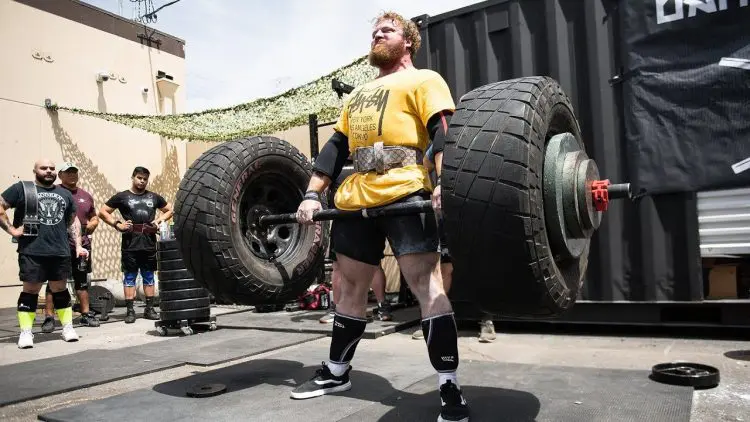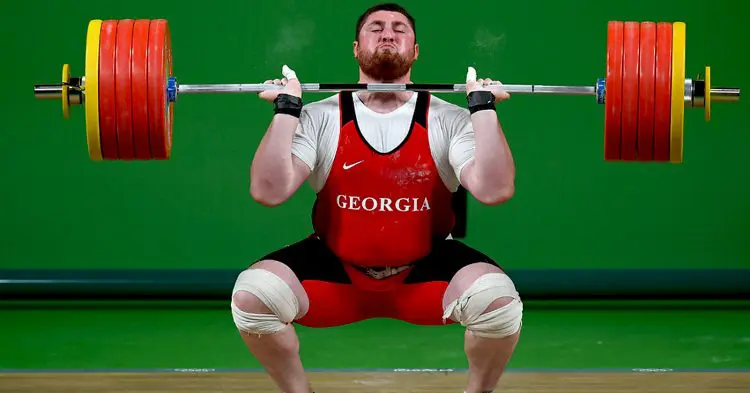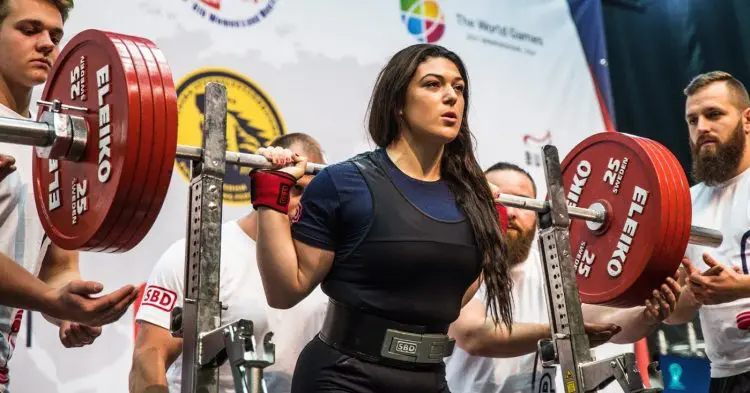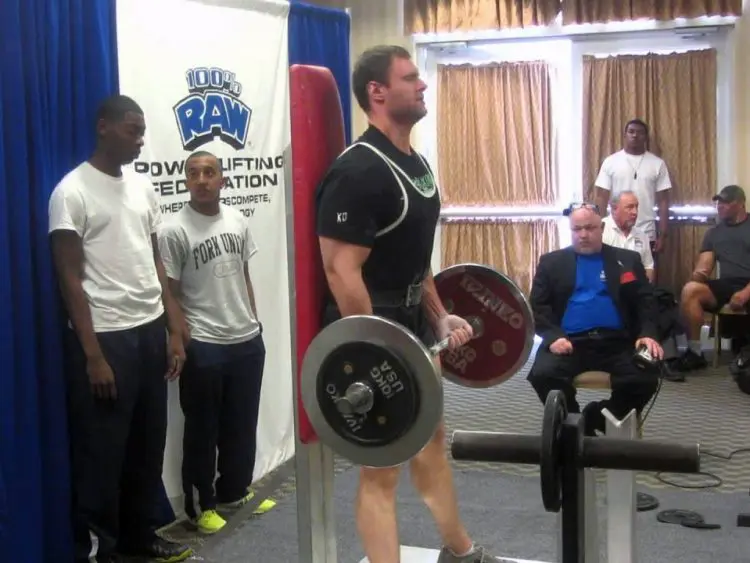Weightlifting is a very generic term used to describe lifting heavy weights. In reality, there are several weightlifting sports, and each one is very different.
Strongman is probably the oldest of the strength sports. There are lots of events in strongman, which is part of its appeal. There are tests of static strength, such as deadlifts and overhead presses, and more dynamic events, such as weighted carries and loading races.
Competitors face a mixture of events, the number, and nature of which varies from one meet to the next. Some meets take a day, while others, like World’s Strongest Man, are spread over several days.
Strongman training often requires specialist equipment. After all, when was the last time you saw a super yoke or an anvil in your gym? Because of this, strongman is not exactly the most accessible weightlifting sport.
And then there’s Olympic weightlifting. This sport revolves around the barbell clean and jerk and the snatch. Equipment-wise, Olympic lifting is much less complicated than strongman, and most gyms have a barbell and weight plates.
Level Up Your Fitness: Join our 💪 strong community in Fitness Volt Newsletter. Get daily inspiration, expert-backed workouts, nutrition tips, the latest in strength sports, and the support you need to reach your goals. Subscribe for free!
However, training for the Olympic lifts usually involves dropping the barbell, so you need bumper plates and a lifting platform. In addition, the Olympic lifts themselves are very technical and hard to learn. This is not an “instant access” sport.
In contrast, powerlifting is a much more accessible weightlifting sport. It involves well-known gym exercises (squat, bench press, and deadlift) and standard workout equipment, which means you can train for powerlifting in a regular commercial gym. However, serious competitors usually train in dedicated powerlifting gyms.
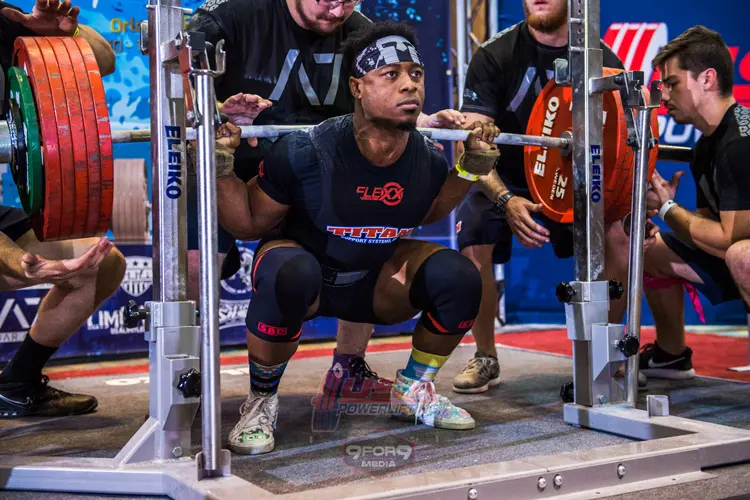
Why the Rules Matter
Powerlifting, like all sports, is governed by rules. The purpose of the rules is to create a level playing field so that all lifters can be fairly compared. With each lifter performing the squat, bench press, and deadlift the same way, the only variable is strength.
There are rule variations from one federation to the next, but the basics are very similar. In this article, we’re going to discuss the basic rules of powerlifting, so you know how each lift is judged.
This will be useful if you are thinking about entering your first powerlifting meet. Newbie powerlifters should also put these rules into practice during training to avoid any unwanted, unpleasant surprises on meet day.
But why should you care about these rules if you aren’t a powerlifter?
Even if you aren’t a powerlifter, it’s useful to follow these rules during your barbell strength-training efforts. The factors that make a legal squat, bench press, or deadlift will also help you get bigger and stronger faster.
They’re also useful safeguards against injury. By standardizing your performance, you make your progress easier to track too.
Clothing and Equipment
You can train in almost any kind of workout clothing, but you need to dress a certain way for competitive powerlifting, and only approved equipment is allowed. The actual equipment permitted depends on whether you are lifting “raw” or “equipped” and varies between federations.
In raw events, you are not allowed to wear support equipment that may improve your performance. Lifting belts, wrist wraps, and knee sleeves are usually permitted, but that’s it.
In contrast, with equipped powerlifting, competitors wear a range of supportive gear, including squat suits, squat briefs, knee wraps, bench press shirts, and deadlift suits. These super stiff and tight garments provide support and also help competitors lift more weight.
There are rules that govern the use of this type of equipment, including what is permissible in terms of layers and thickness.
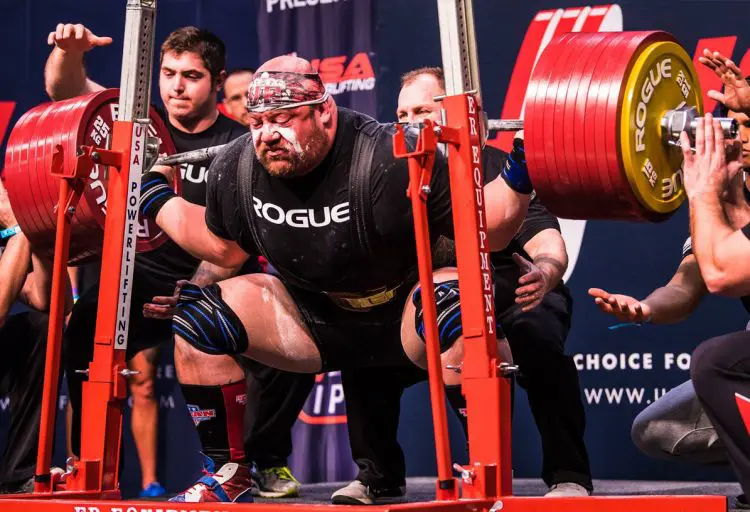
If you are new to the sport of powerlifting, it’s probably best to start with raw lifting. Support gear can be expensive, needs to fit perfectly to work, affects the mechanics of your lift, and is so tight you’ll probably need help putting it on!
In contrast, for raw lifting, while belts, wrist wraps, and knee sleeves are usually allowed, you don’t need to use them. It’s definitely the most accessible form of powerlifting.
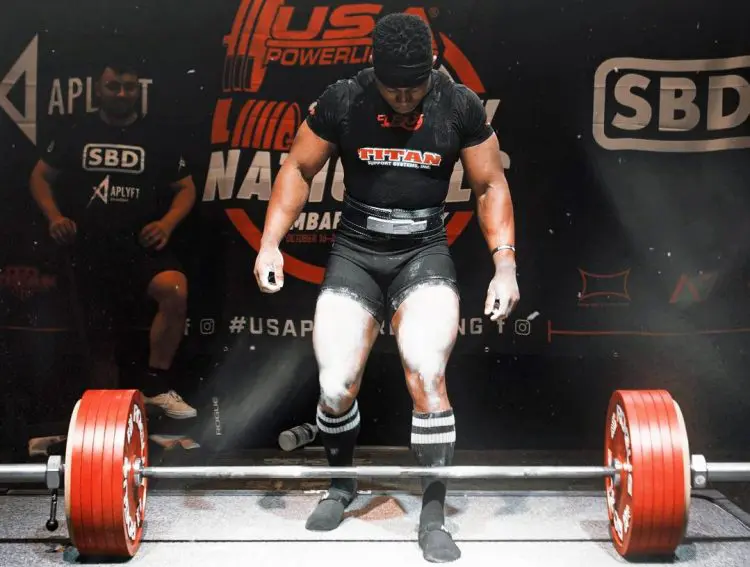
However, for both raw and equipped lifting, competitors must wear a singlet. They must also wear a T-shirt under the singlet for squats and bench presses. Long socks are also compulsory for deadlifts, and shoes must be worn for all three lifts. However, you can wear different shoes for each lift, e.g., weightlifting shoes for squats, sneakers for bench press, and minimalist slippers for the deadlift. Lifting gloves are not permitted.
Read more about difference between Raw and Equipped lifting.
Attempts
Each competitor gets three attempts at each lift. The best, successful lifts are then added together to make your total. The competitor with the highest combined total is the winner.
Lifters choose their own attempts and must tell the organizers their opening weights at the start of the competition. Subsequent weights are then nominated after each attempt. If you fail a lift, you can retake the same weight or increase it, but you cannot ask for a lower weight.
If you fail three attempts in any one lift, you are disqualified from the entire event. Because of this, most powerlifters chose an opening weight they are confident of lifting. That way, even if they miss their next two lifts, they will stay in the competition.
Squat Rules
The squat is the first lift contested in powerlifting. It’s arguably the most difficult in terms of rules too. A lot of newbie lifters are surprised at how deep they have to squat for a powerlifting meet; it can be a real wake up call for all those half-reppers!
After unracking the barbell, you must stand with your legs straight. The barbell must be horizontal, and your feet stationary. The head referee will then give you the command to squat. This is accompanied by a downward arm movement.
Level Up Your Fitness: Join our 💪 strong community in Fitness Volt Newsletter. Get daily inspiration, expert-backed workouts, nutrition tips, the latest in strength sports, and the support you need to reach your goals. Subscribe for free!
Bend your knees and descend until the top surface of your thighs is lower than the top of your knees. It’s up to you to determine if you have achieved the correct depth. You’ll have to do this by feel, as there are no mirrors in powerlifting.
Having hit your depth, you then stand up in one movement. You are not allowed to re-bend your knees at any time. After completing your squat, the head referee will tell you to rack the bar.
Reasons for a failed lift include:
- Starting before receiving the command to squat
- Not squatting deep enough
- Re-bending your knees during the ascent
- Failing to complete the lift unaided
- Re-racking the bar before being told to do so
- Stepping forward, backward, or sideways during the lift
The key to successful powerlifting squats is getting used to hitting depth in training so you can do it without thinking about it in competition. The best way to do this is to train without a mirror.
Box squats can help, as they’ll give you some feedback on squat depth. However, as you’ll have to determine your squat depth for yourself in competition, so the sooner you can do it on your own, the better.
Related: Enhancing Squat Performance With The Smolov Squat Program.
Bench Press Rules
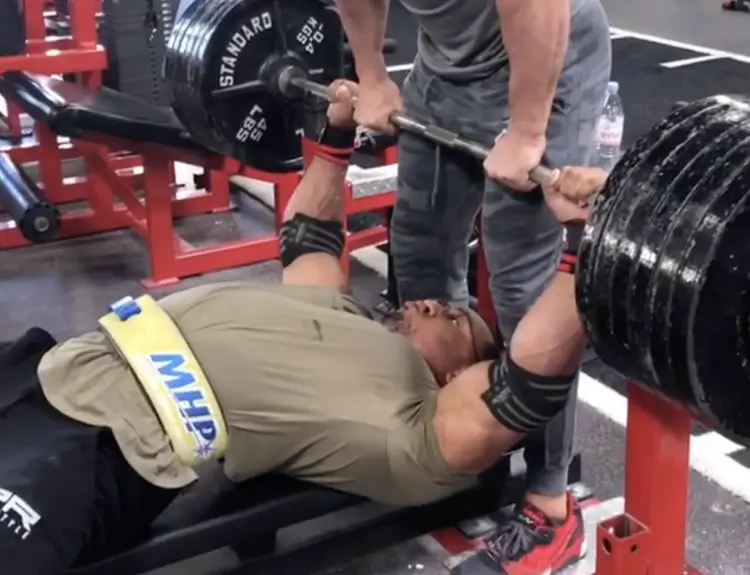
Everyone knows how to bench press, right? But there is a big difference between a standard gym bench press and what you need to do in a powerlifting competition. Many lifters will be surprised to find that they can’t lift as much weight when following these rules.
Once you are on the bench and have gripped the bar, you must wait for the referee to tell you to unrack the bar. You must use a full grip on the bar and not a thumbless or “suicide” grip. Your head, shoulders, and buttocks must be on the bench, your feet on the floor. Your hands should be no more than 81cm/31.88 inches apart.
Unrack the bar and hold it steady. You cannot change your position or move your feet after this. When you are motionless, the referee will give the command to start. Lower the bar to your chest and then pause until the referee gives the instruction to press. Push the bar up to arms’ length. Hold the bar still until you are told to rack it.
Reasons for a failed bench press include:
- Lowering the bar before being told to do so
- Not touching the bar to your chest
- Bouncing the bar off your chest
- Pressing it up before being told to do so
- Moving your feet during the lift
- Lifting your buttocks, shoulders, or head off the bench
- Failing to complete the lift unaided
- Re-bending your arms during the ascent or pressing the bar up unevenly
The pause in competitive bench pressing takes some getting used to, especially if you usually bounce the bar off your chest. That pause, even though it’s very brief, can reduce the amount of weight you usually lift. Because of this, it’s important to use pauses in training so you have an accurate idea of how much you can actually bench press.
Also, many lifters like to do the “bench press shuffle” and move their feet during a challenging set of bench presses. This would lead to your lift being disqualified. Practice pushing your feet into the floor and keeping them still. Not only will this avoid disqualification, but it will also increase tension in your legs, increasing stability and strength.
Some powerlifters bend the rules to their advantage by arching their backs, so they don’t have to lower the bar as far. Reducing the range of motion means you have to do less work, which may mean you can lift bigger weights.
This ISN’T cheating, but it does mean some very mobile lifters have a big advantage over less flexible competitors. However, a giant arch is not the best way to build size or strength, so there is no need for newbie or recreational lifters to do this.
Deadlift Rules
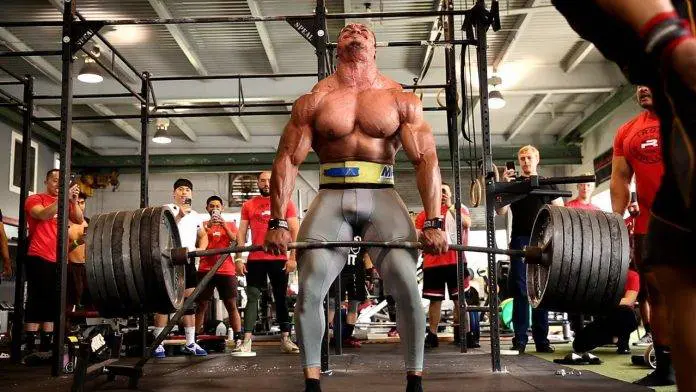
Deadlifts are the final even in powerlifting competitions. They’re also the simplest in terms of rules. After being called to the platform, you grab the bar with your preferred grip and then sumo or conventional deadlift as normal.
Once you are upright and locked out, stand still and wait for the command to put the bar down. This is accompanied by a hand signal. You then lower the bar under control back to the floor.
Reasons for a failed deadlift include:
- Not completing the lift
- Supporting the bar on your knees or thighs
- Moving your feet during the lift
- Not lifting the bar in one movement
- Lowering the bar before receiving the command to do so
- Dropping the bar
Powerlifting deadlifts are more or less the same as regular gym deadlifts. The main exception is that you must wait at the top of the rep to be told you’re okay to return the bar to the floor.
Also, while it’s acceptable to lift the bar slowly and grind out your rep, you cannot rest it on your thighs. However, that maneuver IS permitted in strongman powerlifting events. Lifting straps are NOT allowed for powerlifting deadlifts.
Strict Curl Rules
Some powerlifting competitions also include a strict curl. This is usually treated as a stand-alone event and not included in the three-lift total. However, it’s popular enough that it’s worth knowing the rules of this test of biceps strength.
The strict curl uses an EZ bar. To do this lift, grab the bar with an underhand grip and stand with your feet not more than 12 inches from a wall. Lean back and place your upper back and butt against the wall. Your head and upper arms are free to move.
With your arms straight, on the command start, curl the weight up to your shoulders. Pause at the top and then, when told to do so by the referee, lower it under control back to the start.
Reasons for a failed strict curl include:
- Moving your butt or back away from the wall
- Failing to lift successfully complete the lift
- Not lifting the bar in one movement
- Not following the referee’s instructions
- Moving your feet during the lift
- Using your legs to lift the weight
If you usually do biceps curls with a healthy dose of “body English,” the strict curl will come as a bit of a shock. With no way of cheating the weight up, you will probably be surprised how much less you can lift. However, lifting in this fashion puts much more stress on your biceps, which is good for both strength and size.
Powerlifting Rules – Wrapping Up
Powerlifting is one of the most accessible strength sports. Easier to learn than Olympic lifting, you can train for powerlifting in a conventional gym, and that’s something that you can’t really do for strongman. Most exercisers already to the three powerlifts and should have no problem getting ready to enter a novice competition with just a few months of dedicated training.
If you are thinking about entering a powerlifting meet, make sure you follow these rules in training. That way, things like squat depth and bench presses pauses won’t catch you out.
Even if you aren’t thinking about testing your strength in competition, using these rules will make your workouts more productive. They stop you from cheating, making the big three lifts even more productive. Performing every rep the same also makes it easier to track your progress.

